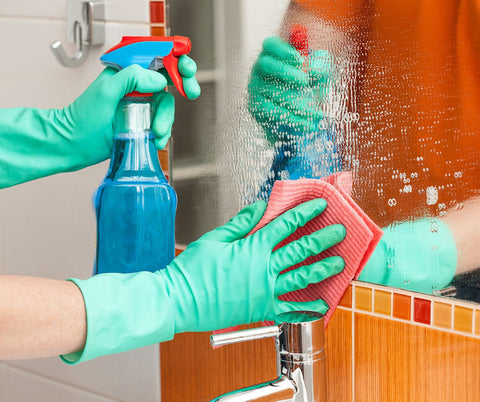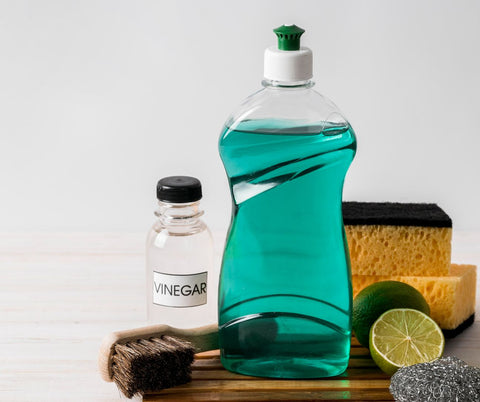Discover the secrets of mirror maintenance in "How to Keep Your Full-Length Mirror Spotless," ensuring your reflection always shines brilliantly. Mirrors, with their captivating ability to reflect light and space, are more than just functional fixtures; they are a cornerstone of interior design. From adding depth to a room to serving as a crucial part of our daily grooming routine, full-length mirrors play an indispensable role in our lives. However, for them to fulfill their purpose effectively, they must maintain their clarity and cleanliness. For many, the process of cleaning a mirror may seem straightforward – a quick swipe with any glass cleaner should do the trick, right? Well, not quite.
The reality is that mirrors require special attention and care to preserve their pristine appearance over time. Ordinary glass cleaners may leave unsightly streaks or even damage the delicate reflective coating on the back of the mirror. To truly master the art of mirror maintenance, we need to explore a range of techniques and materials, some of which might be surprising. But cleaning is only one part of the equation. Mirrors, particularly those in high-moisture environments like bathrooms, face unique challenges such as fogging and moisture damage. This article will explore ways to combat these issues and maintain the longevity of your mirror.
8 Cleaning Hacks: How to Keep Your Full-Length Mirror Spotless
Whether you have a full-length mirror gracing your bedroom, hallway, or bathroom, or you're a business owner looking to keep your commercial space polished and inviting, our comprehensive guide to mirror care will equip you with the knowledge and expertise needed to keep your mirrors spotless and stunning. Let's embark on this journey to mirror perfection, revealing the cleaning hacks that will make your reflection sparkle like never before.
1. Choose the Right Cleaning Solution:

Selecting the appropriate cleaning solution is crucial to ensuring a spotless mirror. Professionals often use a mixture of distilled water and isopropyl alcohol. This combination effectively removes smudges, streaks, and fingerprints without leaving residue. To create this solution at home, mix equal parts of distilled water and isopropyl alcohol in a spray bottle.
Avoid using regular household glass cleaners that may contain ammonia or vinegar, as they can leave streaks and damage the reflective coating on the back of the mirror over time. When using your homemade cleaning solution, be sure to spray it directly onto a lint-free microfiber cloth rather than directly onto the mirror to prevent overspray and dripping.
2. Use the Right Cleaning Tools:

The choice of cleaning tools is equally important. Opt for microfiber cloths or lint-free paper towels to wipe the mirror. These materials are gentle on the glass and won't leave behind lint or fibers, which can mar the reflective surface. Fold the cloth or paper towel into a manageable size and use long, horizontal strokes to clean the mirror from top to bottom. This method helps prevent streaks.
Avoid using abrasive scrubbers, sponges, or rough materials that could scratch the mirror's surface. Additionally, don't use old newspapers for cleaning, as they can transfer ink onto the glass.
3. Regular Maintenance:

Spotless mirrors require regular maintenance. Develop a routine of cleaning your full-length mirror, particularly in high-traffic areas like bathrooms or dressing rooms. Weekly cleaning is a good starting point, but adjust the frequency based on usage. If you notice smudges or spots, address them promptly to prevent buildup that can be more challenging to remove later.
4. Prevent Moisture Damage:

Bathroom mirrors, in particular, are prone to moisture damage, which can lead to fogging and the development of water spots. To prevent this, ensure your bathroom is well-ventilated to reduce humidity. Use exhaust fans or open windows during and after showers to allow moisture to dissipate quickly. Installing an anti-fogging mirror or using a demisting pad can also help maintain a clear reflection in the bathroom.
5. Inspect and Address Edge Issues:

Inspect the edges of your full-length mirror regularly. Over time, moisture or environmental factors can lead to deterioration of the silvering on the back of the mirror, causing black spots or discoloration at the edges. If you notice any such issues, address them promptly by sealing the edges with a mirror-edge sealant or by framing the mirror to protect it from further damage.
Keeping your full-length mirror spotless involves a combination of the right cleaning solution, appropriate cleaning tools, regular maintenance, moisture prevention, and vigilance regarding edge issues. By following these tips, you can ensure that your mirror remains in impeccable condition, providing you with a clear and pristine reflection for years to come.
6. Homemade Vinegar Solution for Stubborn Stains:

For stubborn stains or mineral deposits on your mirror, a homemade vinegar solution can work wonders. Mix equal parts distilled white vinegar and water in a spray bottle. Spray the solution onto the stained area and let it sit for a few minutes. Then, gently wipe the stain away with a lint-free cloth. Rinse the area with clean water and dry it thoroughly to prevent streaks.
7. Dish Soap and Warm Water for Grease and Grime:

If your mirror has accumulated greasy or sticky residues, such as makeup or hairspray, a mixture of warm water and a few drops of mild dish soap can be effective. Fill a basin or bucket with warm water, add a small amount of dish soap, and mix it until it foams slightly. Dip a clean, soft cloth or sponge into the soapy water and gently scrub the affected areas of the mirror. Rinse with clean water and also wipe dry with a lint-free cloth.
8. DIY Anti-Fogging Solution:

To prevent bathroom mirrors from fogging up after showers, create your DIY anti-fogging solution. Mix one part baby shampoo with three parts water in a spray bottle. Shake well before each use. After cleaning your bathroom mirror, lightly mist it with this solution and buff it dry with a lint-free cloth. The thin film left by the baby shampoo helps reduce condensation and fogging.
These additional DIY tips offer effective solutions for tackling specific cleaning challenges, whether it's stubborn stains, greasy residues, or fogging in the bathroom. Incorporate them into your mirror maintenance routine as needed to keep your full-length mirror spotless and crystal clear.
Frequently Asked Questions (FAQs)
1. What do professionals use to clean mirrors?
Professionals often use a combination of distilled water and isopropyl alcohol, commonly known as rubbing alcohol, to clean mirrors. This mixture helps remove streaks and smudges effectively. They may also use microfiber cloths or lint-free paper towels to wipe the mirror without leaving lint behind.
2. How do you maintain a bathroom mirror?
To maintain a bathroom mirror, follow these steps:
- Clean it regularly with a mixture of distilled water and isopropyl alcohol to remove soap scum and toothpaste splatters.
- Avoid using abrasive cleaners or materials that could scratch the mirror's surface.
- Keep the area well-ventilated to reduce humidity, which can lead to moisture damage and fogging.
- Inspect the edges for any signs of silvering degradation and address them promptly to prevent further damage.
3. Is methylated spirits good for cleaning mirrors?
Methylated spirits, also known as denatured alcohol, can be used to clean mirrors effectively. However, it's important to dilute it with water because it is stronger than isopropyl alcohol. A common ratio is one part methylated spirits to three parts water. Always test a small, inconspicuous area of the mirror first to ensure it doesn't cause any damage or streaking.
4. How often do you need to clean a mirror?
The frequency of mirror cleaning depends on the location and how often it's used. In general:
- Bathroom mirrors: Clean these mirrors weekly or as needed to remove toothpaste splatters and water spots.
- Bedroom or hallway mirrors: Dust them regularly and clean when smudges or streaks are noticeable.
- Mirrors in low-traffic areas: These can be cleaned less frequently, such as once a month.
- Public spaces or commercial settings: Mirrors in high-traffic areas may require daily cleaning.
- Adjust the cleaning frequency based on your mirror's condition and usage patterns to keep it looking its best.
In conclusion,
The world of home maintenance, keeping your full-length mirror spotless is like having a magic portal to a cleaner, brighter space. With these cleaning hacks at your disposal, you're armed with the knowledge and DIY tricks to ensure your reflection always shines brilliantly. So, the next time you pass by that full-length mirror, you can do more than just admire yourself; you can admire your mastery of mirror care. From choosing the right cleaning solutions and tools to tackling stubborn stains and preventing fogging, you've got it all covered.
And let's not forget the sense of satisfaction that comes from seeing a spotless mirror. It's not just about vanity; it's about knowing that your living space is well-kept and inviting. So go ahead, put these cleaning hacks to the test, and bask in the spotless splendor of your full-length mirror – a daily reminder that with a little know-how, you can conquer any cleaning challenge and reflect your world in the best possible light. Happy cleaning!










